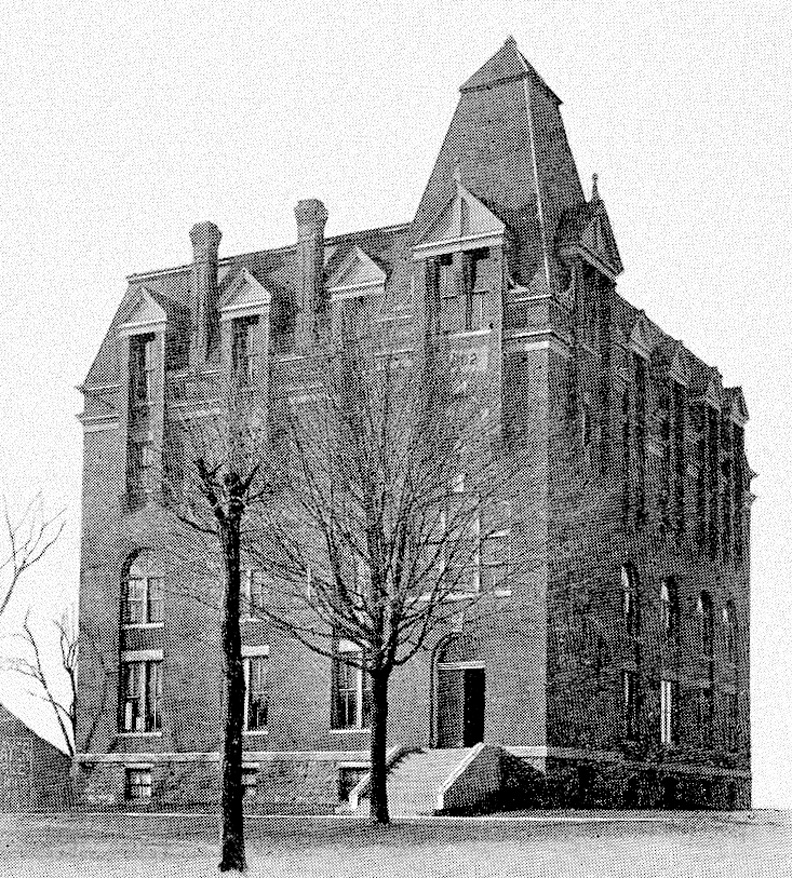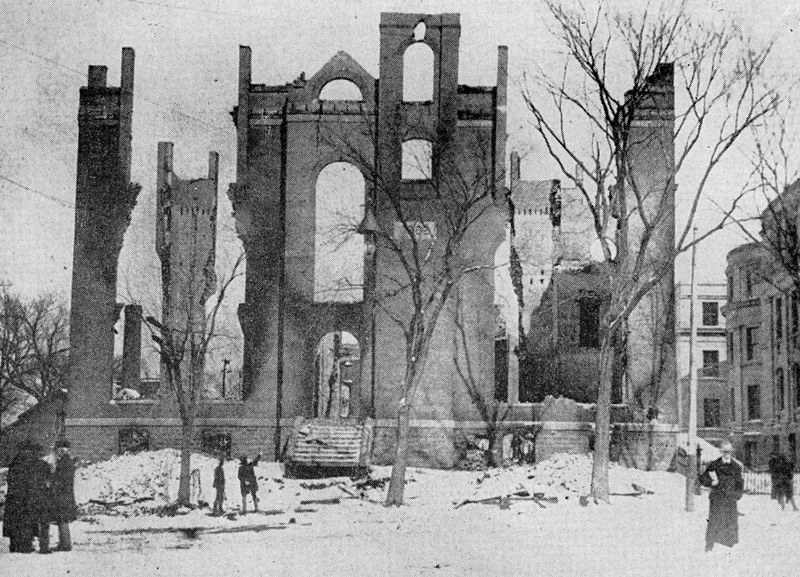
| JOHNSON COUNTY IAGenWeb Project |
Copyright 2003
By Bob Hibbs
Saturday June 21, 2003

A
1907 postmark throws a real curveball at the mind attempting to identify this
old postcard image labeled “Chemical Laboratory,
State University of Iowa.” It turns out to be a remarkable image of a building
which had burned in 1901,
preserved now on a recently-acquired postcard in the Hibbs collection.

Gutted
by fire Sunday morning March 10, 1901, derelict walls of 1882 Medical Building
tower precariously above a light blanket of
sleet and snow along the Washington Street face of Pentacrest Campus. The fire
also razed South Hall located between
Old Capitol and Medical Building and lightly damaged Schaeffer Hall at right.
|
By
Bob Hibbs
An explosion awakened sleepy Iowa City a century ago as fire ravaged nearly one-fifth of all University of Iowa space as it leveled two Pentacrest structures immediately south of Old Capitol. The fire alarm sounded at 2:45 a.m. Sunday, March 10, 1901, stirring the community to action during a nasty spring rain and sleet storm as flames enveloped Medical Building along Washington Street on the southern edge of the main campus area. It threatened South Hall located just 26 feet away and the Kirkwood Hotel across the street.
There
also was fear for Old Capitol itself. Explosion of chemicals in the
medical school’s laboratory awakened many to action. Students, faculty and townspeople rushed to empty South Hall of its engineering college equipment and library as well as the ornate furnishings in the top floor literary society rooms. A heavy flow of water was set up on large engineering school equipment in the basement.
As
a result, these materials and equipment were saved despite the total loss of
1863 South Hall as flames engulfed it just minutes later. Water was spread on the Kirkwood and it was spared. The wooden window trim of Schaeffer sustained limited damage and had to be replaced, but the as yet unoccupied building was spared. Old Capitol likewise was spared. “If it had not been for the rain and sleet, the livery barn and Kirkwood Hotel would very probably have gone the way of the two university buildings,” commented the university Vidette-Reporter newspaper. The Kirkwood name was used by the Burkley family on the then 60-room Burkley Hotel between 1892 and 1902, otherwise operated as the Burkley from 1863 to 1974. The med school lost everything – its entire library, 14 cadavers, numerous anatomy specimens and considerable equipment. The fire was out before daybreak, which brought with it realization of the disaster. During spring 1902 students, faculty and others pitched in to build on the foundation of South Hall a one-story wood-framed structure nicknamed “The Sheep Shed” which continued in use until MacLean Hall construction was initiated in 1911. Replacement space was built off the Pentacrest – the first segment of the Engineering Building across Washington Street completed in 1905, and replacement medical college space catty-cornered across the Jefferson-Dubuque streets intersection from the United Methodist Church. It came into use in 1904. In his 1988 pictorial history of UI, John Gerber reports that medical school faculty member Walter Bierring later would write: “Already on that Sunday morning the vision was clear. Phoenix-like, there would rise from the ashes a greater medical school than ever before.” He seems prophetic a century later after three subsequent cycles of medical college reincarnation, including a $200 million series of projects currently in process. An 1897 fire had gutted the 1866 North Hall just north of Old Capitol and in 1914 fire claimed the first UI Armory and heating plant, a two level 30-foot by 40-foot building located a few feet west of Old Capitol. With loss of the Medical Building in 1901 just before the golden age of postcards, its image on a card must be extremely rare. When one showed up during May, this reporter didn’t recognize the building. Only after a couple of weeks of now-and-then thinking and research did he identify the structure. The 1907 postmark had helped keep him off the mark. No clue if offered to why the card was around six years after the loss of the building to fire. It was printed – probably about 1905 – by John Ries’ Iowa Book Store at 30 S. Clinton St., now home to Gilda Imports.
It
was posted June 5, 1907, is addressed to Libbie Ereth on North Dubuque Street in
Iowa City and is signed “Friend, Clara.” It carries the pointed admonition:
“Don’t let him get ahead of you out there. Fight for your right.” The word
“him” is underlined.
Who
ever said Betty Friedan and Gloria Steinman invented women’s lib during the
1960s?
Next Saturday: Unity Hall – Old U-U Church.
Bob
Hibbs collects local postcards and researches history related to them.
|